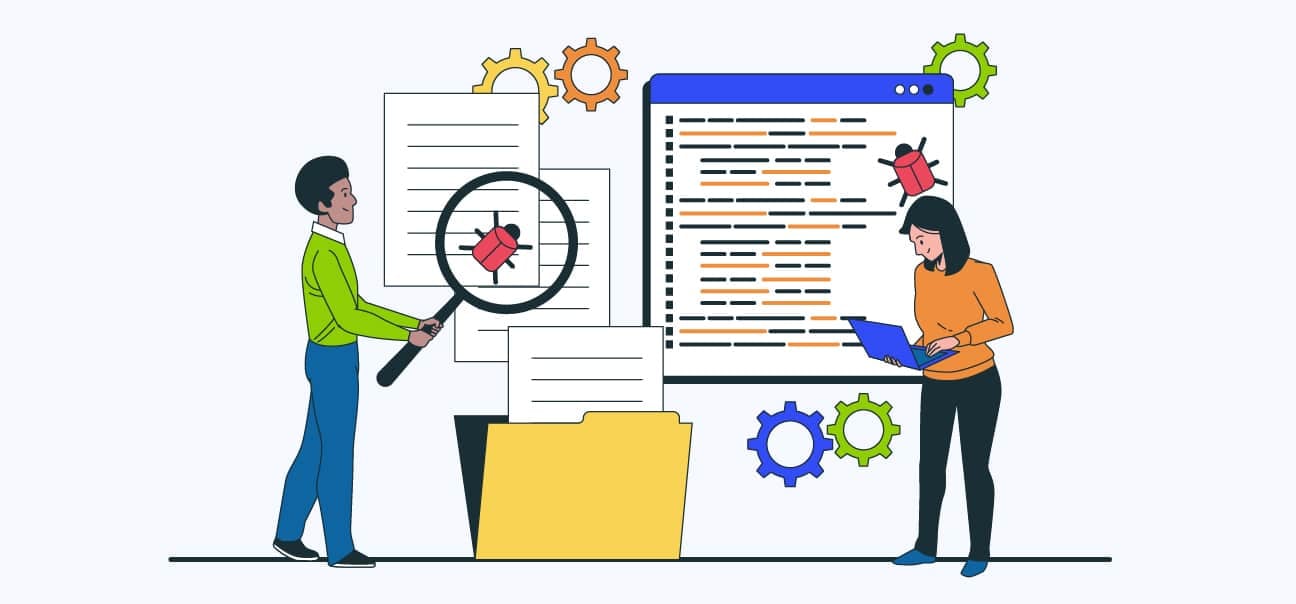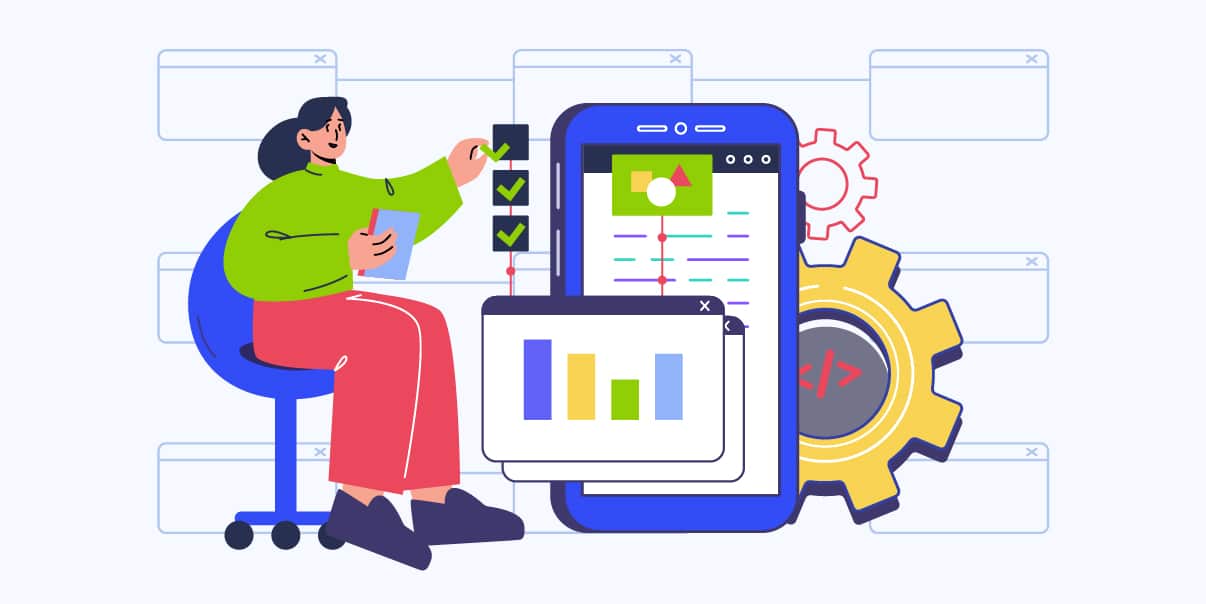What Is Exploratory Testing?
A Comprehensive Guide to Enhance Software Testing

Have you ever found a problem in software or a product you’re working on after it was released? It’s frustrating, right? That’s where exploratory software testing comes in.
Whether you’re a developer, product manager, or tester, keep reading to learn how exploratory testing can help you find more bugs and make better products.
This article will show you how to perform exploratory testing step-by-step and cover all the crucial areas. We’ll also explain how it works in Agile development and share best practices.
What is Exploratory Testing? An Overview
What is exploratory testing? This type of software testing is a flexible approach that lets testers use their creativity and knowledge to find bugs.
Techniques and Strategies in Exploratory Testing
In this section, we’ll explore different techniques for exploratory testing that you can use to help find more bugs and make better products. Let’s dive in!
Freestyle Exploratory Testing Techniques
Freestyle exploratory testing is a straightforward approach. Exploratory testers check the software without a strict plan. They use their knowledge and creativity to find bugs. This way, they expose problems fast and think outside the box. It is also known as informal or ad hoc testing.
Freestyle testing saves time and exposes unique issues. It catches problems other testing methods might miss.
Use freestyle testing for a quick review of a new feature. It’s also good when you have limited time. Or when you want to check how easy the software is to use.
Scenario-Based Exploratory Testing Techniques
In scenario-based exploratory testing, testers create real-life situations. These situations show how users might use the software. Testers check if the software works well in these cases. This method finds issues that regular testing might have left undetected.
Scenario-based testing finds problems that affect the user experience. It also shows how the software works in real life.
To create good scenarios:
- Think about how users will use your software.
- Think about their goals, tasks, and possible problems.
- Include both common and uncommon situations.
Strategy-Based Exploratory Testing Techniques
Strategy-based testing has specific methods. They guide the testing process. There are two main types:
1. Risk-based Testing
Risk-based testing checks the high-risk parts of the software. Testers find areas with potential problems. They test them thoroughly. This method finds critical issues that could harm the software or users.
Risk-based testing helps testers detect critical bugs early. It reduces the overall risk of software failure.
2. Heuristic-based testing
Heuristic-based testing uses rules called heuristics. These rules help testers think about different ways to test the software. Examples include checking error messages and testing with other inputs. They also look for common coding mistakes.
Heuristic-based testing finds bugs more efficiently. It uses a structured approach to testing.
Session-Based Testing Approach
Session-based testing organizes exploratory testing. It is also known as time-boxed testing. In this approach, testers work in focused sessions. These sessions last between 60 to 120 minutes. Each session has a specific goal. For example, a session may test a particular feature or look for a specific bug.
Time-boxed testing helps testers stay focused. It improves productivity and makes tracking progress easier.
To create a time-boxed testing approach, follow these steps:
1. Define the goal.
Decide what you want to achieve during the testing session. Make the goal specific and clear.
2. Set a time limit.
Choose how long the session will last. Keep it short enough to stay focused but long enough to make progress.
3. Take breaks.
After each session, take a short break. The breaks help testers stay focused. Breaks prevent burnout, too.
4. Review and debrief.
After each session, review the results and discuss any findings with your team.
By using these techniques and strategies in your exploratory testing, you can find hidden issues and improve the user experience. These tricks help your software projects become more successful.
Remember, freestyle testing is excellent for a quick review or when you only have limited time. Scenario-based testing helps you understand how your software works in real-life situations. Strategy-based testing, such as risk-based and heuristic-based, enables you to find critical bugs early and work more efficiently. And finally, time-boxed testing keeps you focused and organized throughout the testing stage.
Other Techniques to Use in Exploratory Software Testing
Besides core exploratory testing approaches, you can use other methods to strengthen your testing strategy. This section will discuss how to include boundary value analysis and backward compatibility testing in your exploratory testing strategy.
Boundary Value Analysis
Boundary Value Analysis, or BVA, is a testing technique focusing on input data at the boundaries. Many times, problems happen at the edges of the input domain. BVA helps find issues when the software processes boundary values. This method is beneficial for finding errors in input validation since it tests the system’s limits.
Using BVA in exploratory testing has several advantages:
- You can find defects at boundary conditions more easily.
- You’ll save time and resources by focusing on essential areas.
- BVA works well with other testing techniques, which means better coverage.
To use BVA in your exploratory testing process, do the following:
- Figure out the boundaries. You’ll need to know the range of input data and the minimum and maximum values for each input field.
- Create test cases. Make test cases that focus on the boundary values. The boundary values include the minimum and maximum values. You must also include the values just inside and outside the boundaries.
- Focus on risky areas. Give priority to testing areas where boundary-related defects are more likely to happen. Some examples are input validation and complex calculations.
- Combine BVA with other techniques. Use BVA with other exploratory testing techniques, like freestyle or scenario-based testing, to improve test coverage.
Backward Compatibility Testing
Backward compatibility testing is also known as legacy compatibility testing. It is a way to ensure new software versions or updates work well with older versions. This compatibility is essential for users using previous software versions or systems. If you make your software backward compatible, you can prevent problems arising from incompatibilities between the new and old versions.
Including legacy compatibility testing in your exploratory testing strategy has some benefits:
- It makes the user experience better. Users can move smoothly between different software versions without losing functionality or facing compatibility issues.
- It helps your product’s reputation. Making sure your software is backward compatible shows that you care about quality. It also makes customers trust your software more.
- It cuts down on maintenance costs. If you find and fix compatibility issues early in the development process, you won’t have to spend as much on fixes later.
To add legacy compatibility testing to your exploratory testing process, think about these steps:
- Start by setting up a testing environment. You’ll need a testing environment that copies your users’ older software versions or systems.
- Figure out the essential functions. Decide which features and functions you will test for compatibility between the old and new versions.
- Create test scenarios. Make test scenarios focusing on how the new software interacts with older versions. You’ll want to look at data exchange, file formats, and system integrations.
- Work closely with your team. Talk to developers, designers, and product owners about what you find during testing. Work together to fix compatibility issues as you find them.
Using boundary value analysis and legacy compatibility testing in your exploratory testing strategy can make your testing efforts more effective. You’ll find hidden problems and ensure users have a smooth experience with your software. You can even integrate elements of scripted testing, such as predefined test scripts or test cases, into your exploratory testing strategy to enhance test coverage and efficiency. You can adopt a hybrid exploratory testing approach by including these elements in your exploratory tests.
How to Perform Exploratory Testing
In this section, we will discuss performing exploratory testing effectively.
Test Charter: Foundation for Successful Exploratory Testing
A test charter is a guide for exploratory testing. It outlines the goals, scope, and focus of a testing session. A good test charter helps testers stay on track and make the best use of their time.
To create an effective test charter, follow these steps:
- Define the goal. Be clear about the purpose of the testing session. The objective could be finding bugs in a specific feature or testing the entire application.
- Set the scope. Determine the boundaries of your testing. Identify which parts of the software you’ll focus on and which ones you’ll exclude.
- Identify the focus areas. List the critical aspects of the software that need special attention. These could be dangerous components, new features, or areas with a history of problems.
- Include resources and tools. List any tools or resources you’ll need during the testing session. These things could include test data, test environments, or testing tools.
Concurrent Test Case Design in Exploratory Testing
Concurrent test case design is an aspect of exploratory testing where testers create test cases while testing the software. It is also known as simultaneous or parallel case design. Testers make cases on the fly based on what they find during testing.
The benefits of concurrent case design include the following:
1. Flexibility
Testers can adapt their tests to the current situation, making it easier to find unexpected issues.
2. Efficiency
Testers save time by designing cases while they test instead of creating them beforehand.
3. Better Coverage
Testers can focus on areas that need more attention, resulting in more thorough testing.
To implement parallel case design, follow these steps:
- Start testing the software without pre-designed test cases.
- While testing, identify areas needing more attention or issues.
- Create cases for these areas as you go along, adjusting them based on your findings.
- Document the cases and share them with your team to be used for future testing.
Test Execution and Adaptation in Exploratory Testing
The test execution process in exploratory testing is more adaptive and flexible than in traditional testing. Testers need to be flexible and adapt their tests as they go. Here’s how:
- Start testing with your test charter as a guide.
- As you test, look for unexpected issues or potential problems.
- If you find something interesting, investigate it further. Doing so could involve creating new test cases, adjusting your test charter, or changing your testing approach.
- Keep track of your findings to adapt your testing plan as needed.
- Make decisions during testing based on your findings. You could stop the testing session to fix a critical issue or change the focus of your testing. Or you could explore a different part of the software.
Following these steps, you can perform exploratory testing, find hidden issues, and improve your software projects. Remember to create a clear test charter, use parallel case design for flexibility, and adapt your test execution based on your findings. You can make the most of your exploratory testing efforts with these tips.
Test Coverage in Exploratory Testing
Test coverage is an essential part of exploratory testing. It helps you know how much of your software you’ve tested. Good coverage ensures you’ve checked all the vital details of your software, making it less likely to have hidden bugs.
Measuring Test Coverage
Measuring coverage in exploratory testing can be tricky. Since there’s no strict plan, knowing how much software you’ve tested is complicated. However, you can still measure it in different ways. You can track the features, functions, or user scenarios tested. Or, you can use tools that measure code coverage, like the number of lines of code tested.
Strategies to Improve Test Coverage in Exploratory Testing
To improve coverage in exploratory testing, use these strategies:
1. Use a test charter
A well-defined one helps you focus your testing efforts. It defines your testing session’s goal, scope, and focus areas. By following your test charter, you can ensure that you test the most critical parts of the software.
2. Combine techniques.
Use different exploratory testing approaches, like freestyle, scenario-based, and strategy-based exploratory testing. Each technique focuses on different parts of the software. By combining them, you can cover more ground and find more bugs.
3. Use time-boxed testing.
Organize your exploratory testing into sessions with specific goals. This way, you can keep track of the areas you’ve tested and the ones you still need to test.
4. Collaborate with your team.
Share your test findings and test cases with your team. This way, you can avoid duplicate testing and focus on areas that still need testing.
5. Learn from your findings.
As you find bugs, learn from them. Adjust your testing approach based on your findings to cover areas more likely to have issues.
6. Review and iterate.
After each testing session, review your test coverage. Then, see if the test covers all critical parts of the software. If there are excluded parts, plan additional testing sessions to cover those areas.
Using these strategies, you can improve your coverage in exploratory testing. This way, you can be more confident that your software is free of hidden bugs and ready for users. Good coverage is crucial for the success of your software projects.
Exploratory Testing in Agile Methodology
Agile methodology is a software development approach that values flexibility, teamwork, and quick adaptation to changes. Agile teams work in short periods called “sprints” to create new features and improve the software.
Now, let’s see how exploratory testing fits into this process.
Formal Testing vs. Exploratory Testing in Agile
Agile projects have two main testing types: formal and exploratory. Each plays a crucial role in ensuring software quality.
1. Formal Testing
Formal testing is a structured way of testing where testers follow a plan and use predefined test cases. It checks if the software works as expected. Teams usually do this during each sprint in agile projects.
2. Exploratory Testing
Exploratory testing is a more flexible approach. Testers use their knowledge and skills to find hidden issues. It focuses on the user experience and how the software works in real situations. In agile projects, it can happen anytime during the development process.
Both formal and exploratory testing play important roles in agile projects. They help ensure the software meets the requirements and performs well for users.
Integration of Exploratory Testing in Agile Projects
To integrate exploratory testing in agile projects, you must collaborate, plan, and use the right tools. Here are some practical steps to help you effectively incorporate exploratory testing into your agile projects:
- Include exploratory testing in project management sprints. When planning sprints, allocate time for exploratory testing activities. Doing so ensures that exploratory testing becomes an integral part of your agile process and contributes to the overall quality of the project.
- Use collaboration tools for seamless communication. Encourage testers, developers, designers, and product owners to work closely. Use collaboration tools like Slack, Microsoft Teams, or Trello to share insights, ideas, and findings to improve the software and the testing strategy.
- Use testing tools that integrate with development environments. Choose testing tools that easily integrate with your team’s preferred development environment, like Jira or Git. These tools will help streamline the exploratory testing process and facilitate communication between testers and developers.
- Integrate exploratory testing with Continuous Integration (CI) and Continuous Deployment (CD). Incorporate exploratory testing into your CI/CD pipeline to catch and fix issues quickly. This practice helps maintain a high-quality codebase and supports agile principles.
- Use test management software with built-in exploratory testing features. Select a test management tool that has features designed explicitly for exploratory testing, such as session tracking, time-boxing, and detailed reporting. These tools can help testers plan, execute, and report their exploratory testing sessions more efficiently.
- Create a test charter for each exploratory testing session. A well-defined charter helps guide testers during their sessions. It should include the goal, scope, focus areas, resources, and tools needed for the session, ensuring that testers stay on track and cover essential software parts.
- Share findings and iterate. After each testing session, document and share the results with your team. Doing so enables your team to address issues and improve during the sprint. Continuously refine your exploratory testing process based on findings and feedback to make testing more effective.
By following these steps, you can effectively integrate exploratory testing into your agile projects. This integration helps find hidden issues and improves your software’s overall user experience and adaptability. Integrating exploratory testing into your agile workflow ensures more comprehensive testing, resulting in higher-quality software products.
In conclusion, exploratory testing is an excellent addition to agile projects. Exploratory tests work well with formal tests to help teams create high-quality software quickly. Adding exploratory testing to your agile projects helps ensure your software meets users’ needs and performs well in real-life situations.
Best Practices for Effective Exploratory Testing
In this section, we’ll go over best practices for successful exploratory testing. We’ll focus on how to make your testing strategy better, improve documentation, and keep learning.
Tips for Successful Exploratory Testing
Here’s how you can make your testing better:
- Set clear goals. For each testing session, have specific objectives. Clear goals help testers stay focused on essential software areas.
- Get a diverse team. Include testers with various skills and backgrounds. People with different skills and experiences provide different perspectives. Diversity helps find more issues in the software.
- Set time limits. Set a time limit for each session. With a time limit, testers can stay focused and avoid getting tired. For example, a session could be 60-90 minutes.
- Focus on risky areas. Test software parts that have more problems than others. Some examples are new features or complex functions.
- Work with developers. Talk to developers during testing. Share findings to help fix issues faster. If everyone is transparent, everyone can work together more efficiently.
Documentation and Reporting in Exploratory Testing
Documentation and reporting are vital in testing. Without detailed notes and reports, developers must re-do everything the testers did to find issues. Repeating the whole testing from scratch takes a lot of time.
The point of having testers is to have them do the heavy lifting in finding bugs. Documentation helps testers share the bugs they find with the people who will fix them.
Here are some tips about documentation and reporting:
- Record sessions. Use tools like Camtasia or OBS Studio to record testing sessions. Videos help reproduce issues and share findings.
- Take notes. Encourage testers to use tools like OneNote or Evernote for note-taking. Notes help document issues and insights. Developers can use testers’ notes to fix problems.
- Report bugs. Write clear bug reports. Include steps to reproduce, severity, and impact. Bug reports help developers resolve issues faster.
- Keep a test log. Record all testing activities using tools like Jira or Trello. Logs allow you to track progress and plan future testing.
- Share findings. Regularly talk to the team about testing results. If everyone is on the same page, everyone understands the issues and can work together better.
Continuous Improvement and Learning
Continuous improvement in exploratory testing is a way to make the testing process better and more effective. It is crucial for successful testing. It helps testers learn from what they find and makes their work better.
Here are some tips for continuous improvement:
1. Reflect on testing.
Review past testing sessions. Identify areas to improve. Discuss observations with your team and ask for their feedback.
2. Use feedback.
Encourage team members to give feedback on testing processes, tools, and techniques. Make improvements based on their input.
3. Stay current.
Learn about the latest testing methods and tools. Subscribe to blogs, attend webinars, and join conferences. With this knowledge, you can adapt your testing plan as needed.
4. Learn from mistakes.
When testers find issues, you and other team members should analyze the bugs’ cause. Determine what could have been done differently during testing. Use this knowledge to prevent similar issues in the future.
5. Train team members.
Share your knowledge with your team. Encourage them to attend training and conferences to improve their skills and stay current with industry trends.
By following these best practices, your exploratory testing will be more effective. Remember to set clear goals, work with your team, document well, and improve your testing strategy. With these practices, your exploratory testing efforts will help create better software products.
Conclusion
Throughout this article, we’ve discussed the ins and outs of exploratory testing. We covered essential concepts, techniques, and practices, such as planning sessions, using test charters, and focusing on high-risk areas. We also examined the role of exploratory testing in agile methodology. We shared best practices for adequate testing, documentation, and continuous improvement.
Exploratory testing plays a significant role in the software testing process. It helps identify hidden bugs and enhances the overall quality of software products. Implementing the discussed techniques can make your operation more efficient and effective.
At BIT Studios, we can improve your software testing capabilities and incorporate exploratory testing into your development process. We can help you create high-quality, reliable software products. Contact us today and take your testing efforts to new heights.
We’re BIT Studios!
At BIT Studios we specialize in designing, building, shipping, and scaling beautiful, usable products with blazing-fast efficiency



